PIKACHL TAIL SCARF
By Panandora Needle Size: 10.5 US (6.5mm) Yarn: Worsted This is the first knitting pattern I've ever made - hopefully it makes sense. Feedback is awesome. The scarf is mostly seed stitch, but the zigs and zags come from adding and combining stitches. The color transition part - if you have a better suggestion on how to do that, let me know.
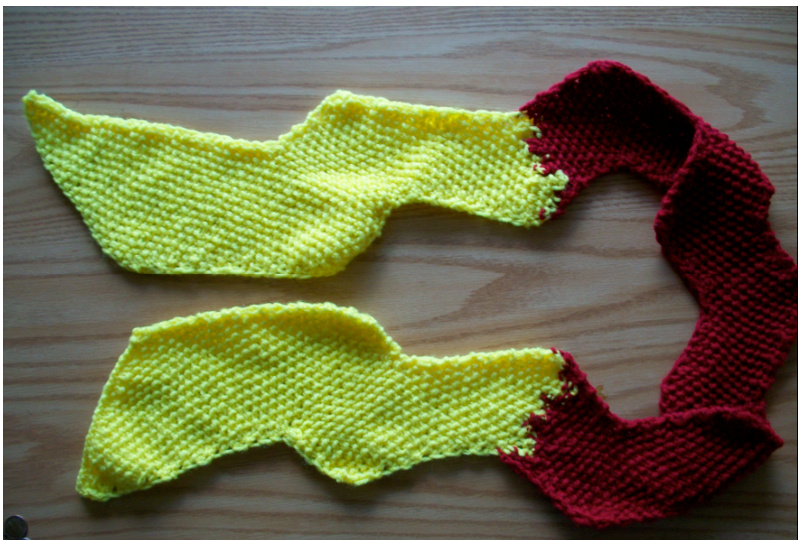
S = Slip stitch P = Purl K = Knit K2tog = Knit two stitches together P2tog = Purl two stitches together KFB = Knit one front and back . = Continue K P pattern The scarf is made in 6 or 4 row blocks that 'zig' or \`zag' (slant left or right) and increase, decrease, or remain constant in width. The stitching is slightly different if the row starts with an odd or even number of stitches, so keep track when increasing or decreasing the number of stitches in a row. The scarf, by block type: Cast on 25 stitches. Zig Decrease x5 Zag Decrease x2 Zig Decrease x2 Zig Constant x3 Zag Constant x5, first two are the color transition Zig Constant x5 Zag Constant x5 Zig Constant x5 Zag Constant x5 Zig Constant x5 Zag Constant x5 Zig Constant x5, last two are the color transition Zag Constant x3 Zag Increase x2 Zig Increase x2 Zag Increase x5 Cast off!
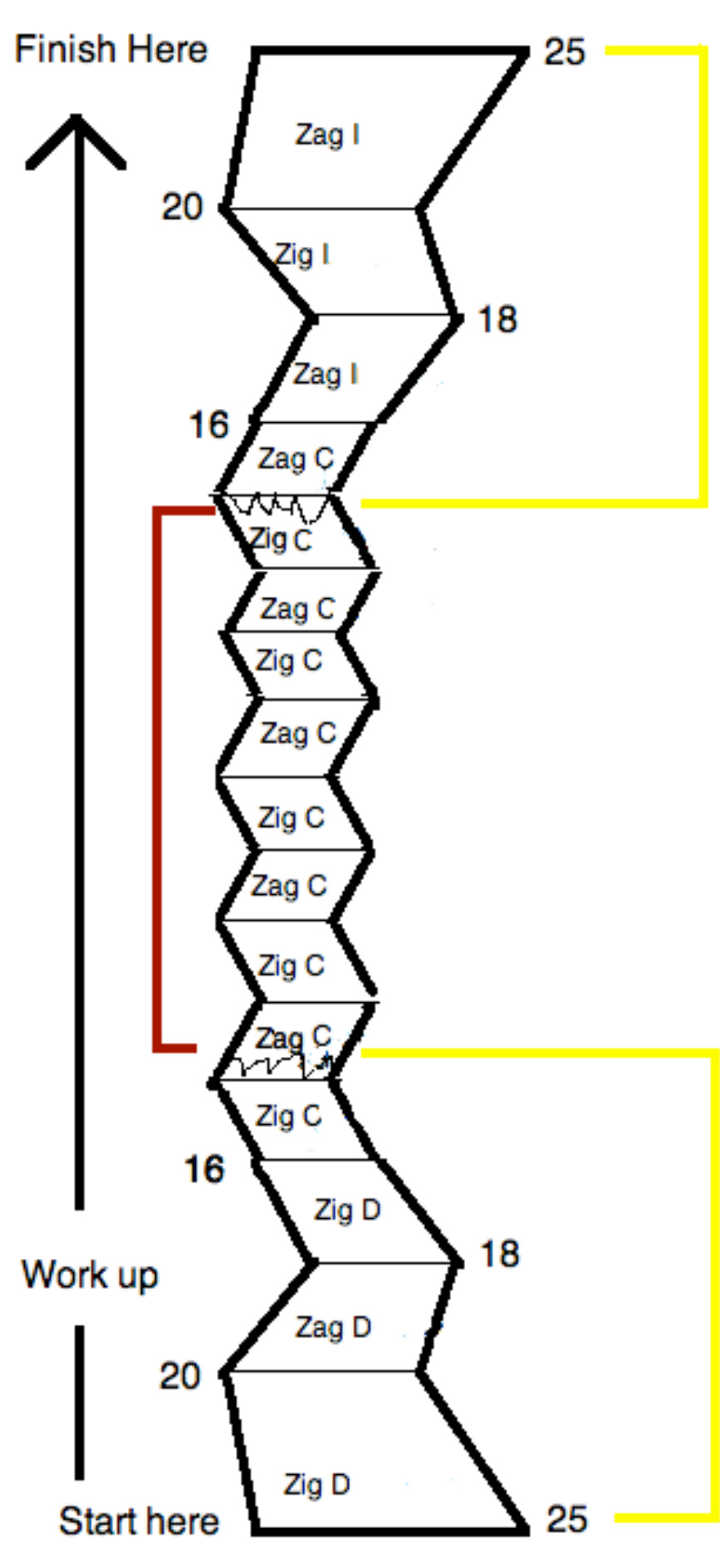
This pattern is for personal use only. http://panandora.blogspot.com/
Zig Decrease
Starting with an odd number of stitches. Row1:S PKP ....KPK Row 2: S K2tog P ... K KFB P Row3:SKPK .... PKP Row 4: S P2tog K ... P KFB K Row 5: S P K ....P K2tog P Row 6: S P2tog K P .... K KFB P This ends with an even number of stitches.
Zig Increase
Starting with an odd number of stitches: Row 1: S KFB P K P .... K P Row 2: S P2tog K .... P K KFB P Row 3: S K P K ... P K Row 4: S K2tog P K .... P KFB K Row5:S P K ....PK P Row 6: S P2tog K P .... K KFB Starting with an even number of stitches: Row 1: S KP .... K P K Row 2: S K2tog P K .... P KFB K Row3:S P K ....PKP Row 4: S P2tog K ... K KFB P Row 5: S K P K ... P K2tog P Row 6: S P2tog K ....P KFB K This ends with an odd number of stitches. Starting with an even number of stitches: Row 1: S KFB P K ...P K Row 2: S K2tog P ... K KFB P Row 3:SKP ....K P Row 4: S P2tog K .... P KFB K Row5:S P K ....PK Row 6: S K2tog P ..... K KFB P
Zag Decrease
Starting with an odd number of stitches: Row 1: S K P ....K P Row 2: S KFB P K P .... K P2tog K Row 3: S P K .... P K Row 4: S KFB K P K ... P K2tog P Row 5: S P2tog K .... P K P Row 6: S KFB P K ... P K2tog P
Zag Increase
Starting with an odd number of stitches: Row 1:SP K P ....K KFB P Row 2: S KFB P K .... P K2tog P Row3:SKP ....KPK Row 4: S KFB K P .... K P2tog K Row5:S PK ....PKP Row 6: S KFB P K ... P K2tog P Starting with an even number of stitches: Row 1:SKP ....KPK Row 2: S KFB K P .... K P2tog K Row 3:S P K ....P KP Row 4: S KFB P K .... P K2tog P Row 5: S P2tog K .... P K Row 6: S KFB K P K .... P K2tog P Starting with an even number of stitches: Row 1: S K P ....K KFB P Row 2: S KFB P K P .... K P2tog K Row 3:S P K .... P K Row 4: S KFB K P K ... P K2tog P Row 5: S K P .... K P Row 6: S KFB P K P ... K P2tog K
Zig Constant
This should only ever be even. Row 1: SKP ... K P K Row 2: S K2tog P K .... P KFB K Row 3:S P K ...PKP Row 4: S P2tog K ... K KFB P
Zag Constant
Row 1: S K P .... K P K Row 2: S KFB K P ...K P2tog K Row3:SPK ...PKP Row 4: S KFB P K .... P K2tog P This pattern is for personal use only. http://panandora.blogspot.com/ Color transition: I don't actually know a good way to do this. Since I wanted a zig zag in the transition, like Pikachu's tail, I didn't want to just change yarn colors. Also, it was a scarf and both sides are visible, so I didn't want stands to go across a back side. These are the color patterns you want. The first is the to red transition the second is the back to yellow. Both start from the bottom left. If you don't feel like trying to decode my wacky improv way, you can work a color, and when it changes, chop the end off the yarn, tie the new color at the end and repeat. This way, you only have one strand of yarn dangling from your project at a time.


When you do the first transition, the first four rows are the first Zag Constant block. The next two are the first two rows in the second one. On the second transition, the first two rows are the last two in the fourth Zig Constant block. The next four are the last Zig Constant block. This pattern is for personal use only. http://panandora.blogspot.com/ If you are feeling brave, you can try the way I came up with. You tie less knots with it, but it involves having multiple pieces of yarn dangling from the project. At the end, you are back down to one strand of the new color. I think this is easiest to show visually, so here it goes. Every time I needed a new color, I tied the new strand to the existing strand and continued to knit with both according to the color pattern.
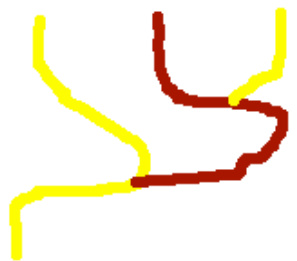
When it was time to tie out, I tied the end of the finished strand to the strand that wascontinuing.
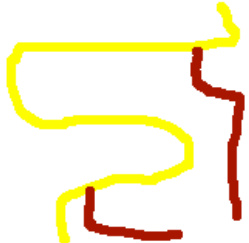
hmmm... those are pretty ambiguous paint sketches. I found it easiest to tie the yarn in and out before I made the first or last stitch with it so there was actually an end to work with. I also made a mock up of the transition out of scarp yarn before I started knitting it in the scarf to make sure it worked. This pattern is for personal use only. http://panandora.blogspot.com/ This is the tie in/out map I used.
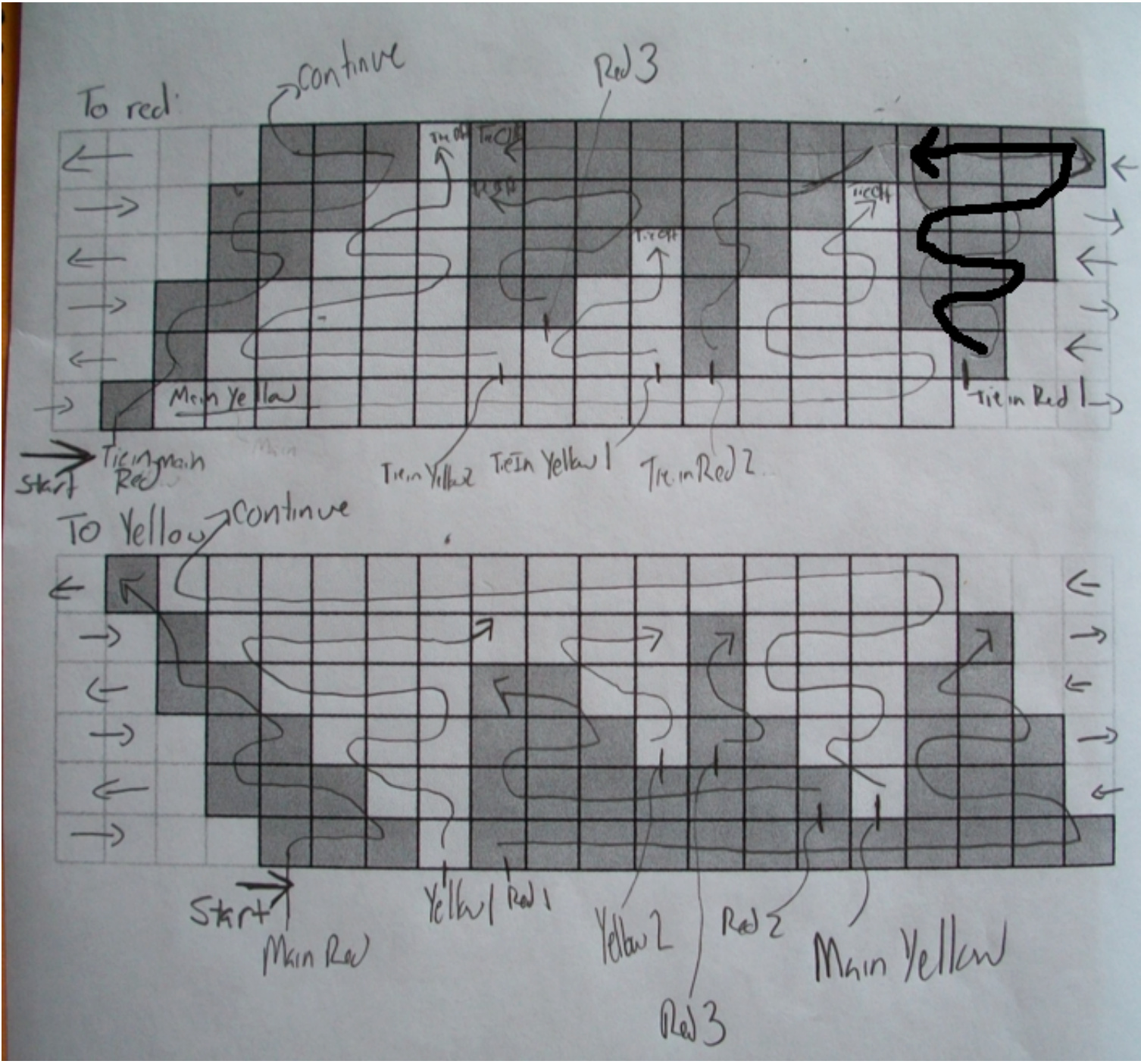
Hopefully that makes some sense. I highly recommend threading piece of extra yarn through all your stitches before you start the transition so if it starts to fall apart, you can just pull out all the new stitches and put the pre transition project back on your needles. This pattern is for personal use only. http://panandora.blogspot.com/









